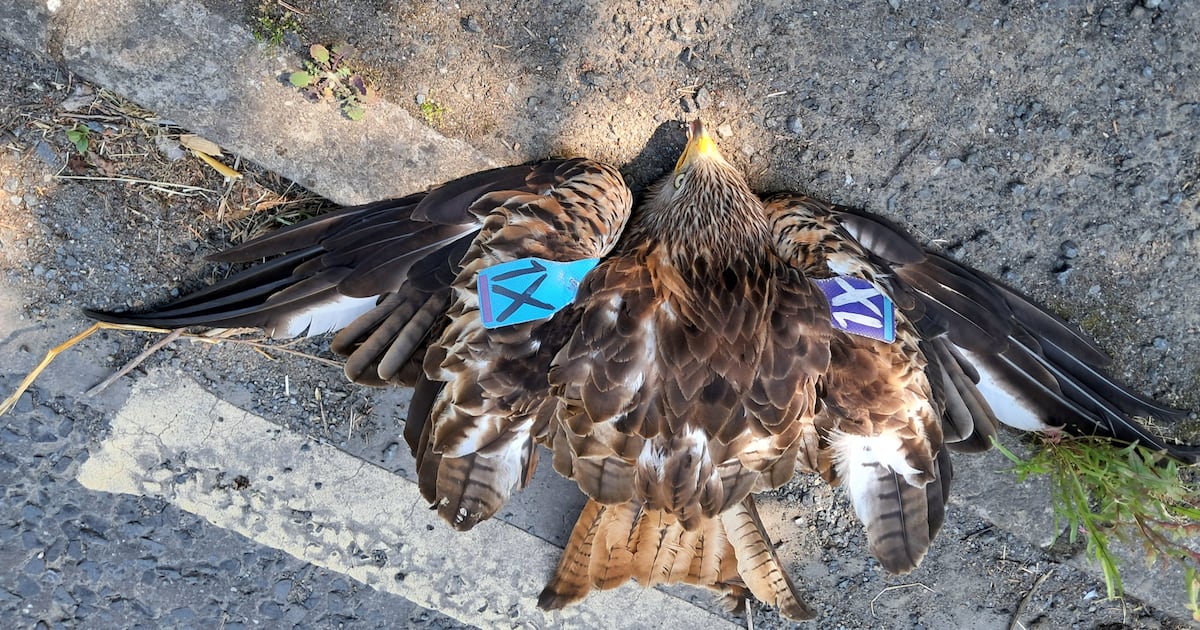Top Stories
Red Kites Flourish in Ireland but Face Road Hazards

A recent incident involving a red kite in Ireland highlights the ongoing challenges faced by this recovering species. A cyclist discovered the bird, injured after being struck by a vehicle while feeding on a pigeon outside a residence. The cyclist, Nigel Murtagh, promptly reported the situation to Birdwatch Ireland and an OPW ranger who later collected the bird from the garden.
Red kites, which were once common in Ireland, became extinct as breeding birds by the 19th century due to factors such as poisoning and hunting. They were reintroduced into various regions, including Wicklow in 2007, Co Down in 2008, and Fingal in 2011. Currently, they are successfully breeding in these areas. Nestlings are ringed and fitted with wing tags for identification, enabling wildlife enthusiasts and researchers to monitor their flight patterns.
Despite their conservation success, red kites face significant threats from human activity. While they primarily hunt for live prey, they also scavenge on carcasses, which can expose them to poisons such as rodenticides. Furthermore, their tendency to feed on roadkill puts them at risk from passing vehicles. Murtagh’s observation serves as a reminder of the dangers that these birds encounter in their everyday lives.
In a separate nature observation, Úna Smart shared her experience of encountering an unusual insect while sitting in Mullaghmore, Co Sligo. Initially mistaking it for a Japanese hornet, Smart was corrected by fellow nature enthusiast P McGinty who identified it as a harmless ichneumon, specifically Amblyteles armatorius. This insect lays its eggs in caterpillars, which the larva subsequently consume from within.
The article also noted the increasing presence of the comma butterfly, a species that has expanded its range in Ireland due to climate change. First recorded in Wexford’s Raven Nature Reserve in 2000, comma butterflies have since been spotted in nearly every county except Donegal and Leitrim.
Additionally, local resident Frank Folan inquired about a rock formation near Claggan on Clew Bay, wondering if it was fossilized coral. An expert confirmed that it was actually a cluster of fossilized crinoid stems from the Carboniferous period, approximately 350 million years ago. Crinoids were marine creatures living in shallow tropical seas, and their remains are found embedded in limestone throughout parts of Ireland.
Finally, Anita Fennelly shared her encounter with a small, chestnut-colored mammal near the Barrow Estuary in Co Kilkenny. Misleading suggestions from artificial intelligence led her to question whether it was a bog lemming or a Californian vole. An expert clarified that it was a bank vole, a common rodent in the region.
These observations and inquiries underline the rich biodiversity in Ireland and the importance of continued awareness and conservation efforts to protect both familiar and emerging species. For those wishing to contribute to nature discussions, Éanna Ní Lamhna, a biologist and contributor to The Irish Times, encourages readers to submit their nature queries or observations, ideally accompanied by photographs and location details.
-

 Top Stories3 months ago
Top Stories3 months agoTributes Surge for 9-Year-Old Leon Briody After Cancer Battle
-

 Entertainment4 months ago
Entertainment4 months agoAimee Osbourne Joins Family for Emotional Tribute to Ozzy
-

 Politics4 months ago
Politics4 months agoDanny Healy-Rae Considers Complaint After Altercation with Garda
-

 Top Stories4 months ago
Top Stories4 months agoIreland Enjoys Summer Heat as Hurricane Erin Approaches Atlantic
-

 World5 months ago
World5 months agoHawaii Commemorates 80 Years Since Hiroshima Bombing with Ceremony
-

 Top Stories3 months ago
Top Stories3 months agoNewcastle West Woman Patricia Foley Found Safe After Urgent Search
-

 Top Stories5 months ago
Top Stories5 months agoFianna Fáil TDs Urgently Consider Maire Geoghegan-Quinn for Presidency
-

 World5 months ago
World5 months agoCouple Convicted of Murdering Two-Year-Old Grandson in Wales
-

 World5 months ago
World5 months agoGaza Aid Distribution Tragedy: 20 Killed Amid Ongoing Violence
-

 World5 months ago
World5 months agoAristocrat Constance Marten and Partner Convicted of Infant Murder
-

 Top Stories4 months ago
Top Stories4 months agoClimbing Errigal: A Must-Do Summer Adventure in Donegal
-

 Top Stories4 months ago
Top Stories4 months agoHike Donegal’s Errigal Mountain NOW for Unforgettable Summer Views









